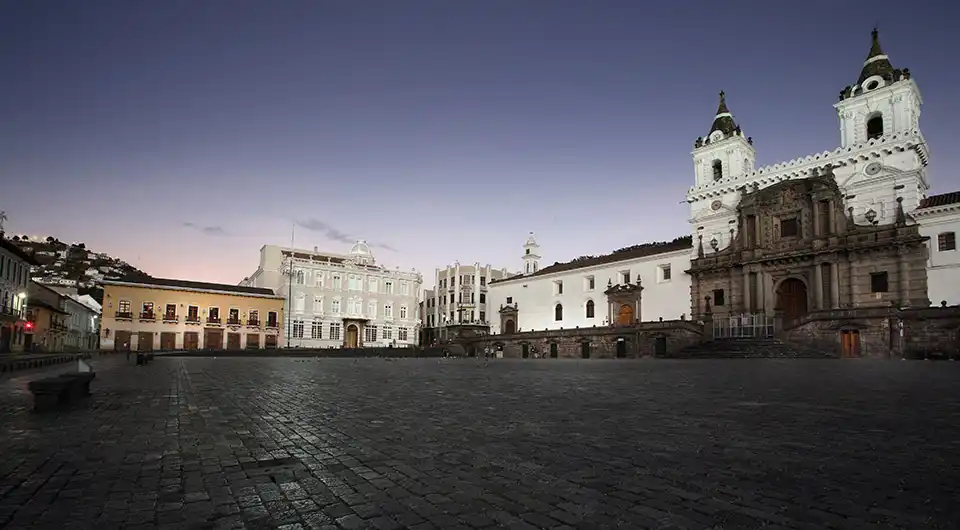Experiencing the life, history, and people of San Francisco Plaza from Casa Gangotena isn’t a big event — it’s simply what happens every time you step foot outside of your Quito hotel. No other hotel in the city offers this kind of immersion in the Old Town’s most iconic hub.
The best time to see San Francisco Plaza is in the violet light of dawn, free of people, before it’s had a chance to put on its makeup and compose itself. At this early hour, from the viewpoint of the third-floor terrace of Casa Gangotena (or any of the plaza-facing bedrooms of the best hotel in Quito), you can see how this iconic square fits into the city: flanked by domes and spires with the snow-capped peak of Cayambe volcano off in the misty distance.
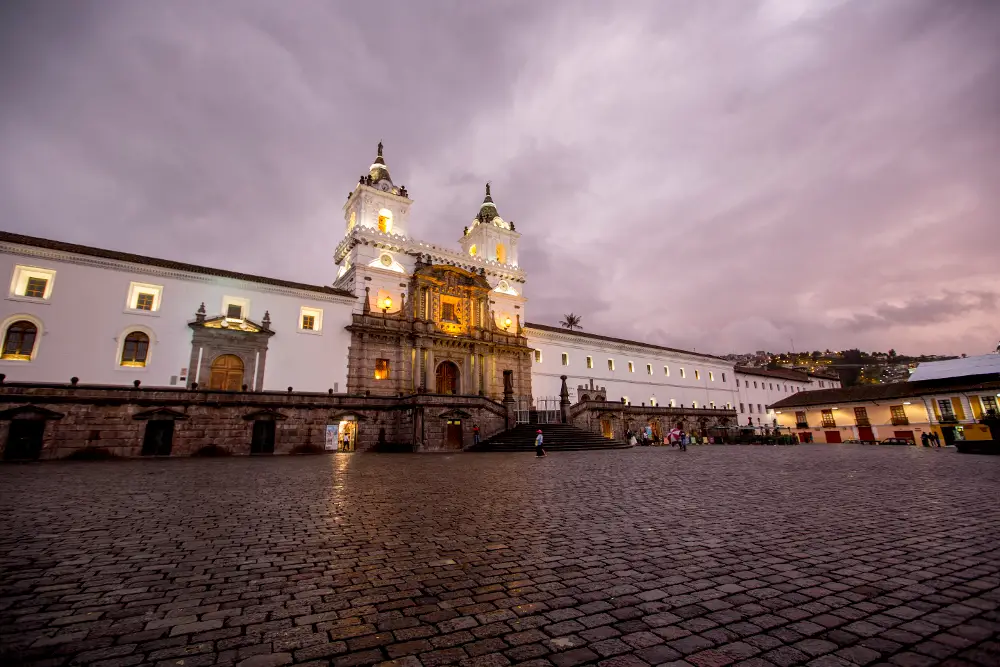
Much more than a casual observer, Casa Gangotena is a prestigious member of the San Francisco Plaza, occupying the southwest corner of the square itself as a remarkable addition to this thoroughly Quiteño hallmark. From this boutique hotel in Quito, you don’t just see what’s going on in the square, you actually become a part of it. From the gawping tourists to the brown-cassocked monks in a hurry, all the way to the calls of its vendors and the flight of its pigeons; you can almost feel the energy of life as it swirls around you. As such – the comings and goings of the Plaza are every bit the comings and goings of Casa Gangotena.
What’s the history of the San Francisco Plaza in Quito?
According to historians, before it became the San Francisco complex in the 16th century, the space that Casa Gangotena looks onto was once occupied by the royal palace of Huayna Cápac, the great Inca Emperor, as well as a ceremonial temple for this Pre-Columbian society. Most historians agree that, before the Franciscans began construction on the remarkable plaza and its Church and Convent, the square itself was a bustling weekend market. Though not a fully-fledged city, Quito at that time was a hub, or exchange point between chiefdoms located around the volcanic mountains of the Andes. It was for this reason, due its strategic importance, that the Spanish and their religious orders chose to build their flagship complex right here. It’s also the reason for why the land that Casa Gangotena now occupies is of such significance to the history and identity of Quito’s Old Town.
Fast forward to today, and one can see the influence of this square (and what the Spanish built here) all throughout the Old Town: dozens of churches are now found on nearly every block. The San Francisco Plaza, in effect, sparked the religious flame all throughout Quito, serving as the root of all religious complexes that came to be built throughout the greater part of the city’s center. In fact, San Francisco de Quito served as the pre- and post-Hispanic religious hub of the Americas for a long time.
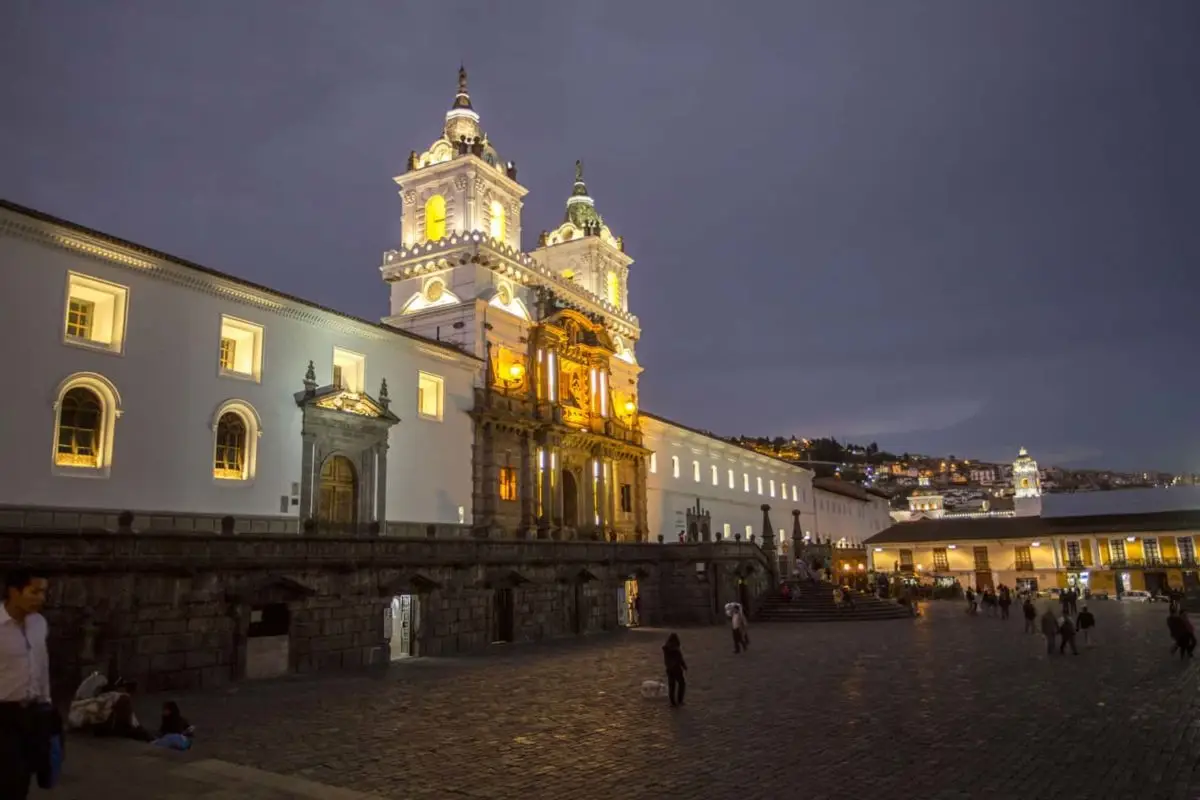
So ingrained is the significance and importance of San Francisco Plaza, that even the highly revered procession of Jesus del Gran Poder, for example, begins right in the Plaza and passes right by Casa Gangotena along Simon Bolivar street; Casa Gangotena’s has been continuously named the best downtown hotel in Quito thanks to its third-floor terrace, this is the best place to watch the engrossing march of participants clad in purple robes and hoods carrying massive wooden crosses. Throwing rose petals down onto them from this privileged spot has been the tradition here for centuries, one that only guests of Casa Gangotena can enjoy today.
And while the Plaza itself is attached to the San Francisco religious complex (built by Franciscan monks in 1537 and said to be Latin America’s oldest church) the plaza’s role is more than merely ceremonial – it is the beating heart of Quito Old Town life, where commerce, dining, religion and luxury collide.
Such historic references are felt throughout Casa Gangotena, predominantly in the restaurant, where the menu concept, Cocina Mestiza, seeks to honor the long, rich history of the area surrounding Casa Gangotena. This emerges in the beautiful, hand-painted or volcanic rock plates, in the dishes themselves that are riffs on centuries of local culinary traditions, and in the ingredients, many of them heritage products rescued from oblivion by the passionate chef.

And though it seems to have emerged from Quito’s very DNA, the sloped square hasn’t always looked this way – a plane of grey cobbles, uncluttered by benches or sculptures. It was only covered in its emblematic cobble stones in 1940; before that it was a barren pitch that hosted crowd-pleasing activities like plays, markets, bullfights, processions, farming workshops, and the mass catechism of natives.
For a short while it was landscaped into formal French-style jardins. Paintings reveal that during Colonial times, a large stone fountain rose from its heart, from which indigenous ‘carriers’ would collect water in huge ceramic urns to share across the city’s neighborhoods.
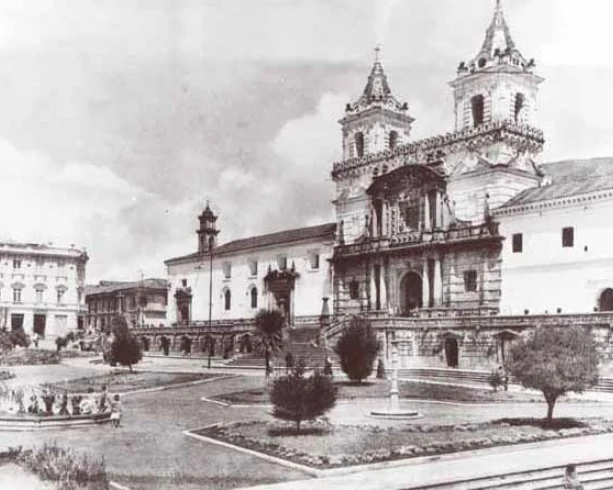
What’s the story behind the San Francisco Church and Convent?
It is impossible to talk about Plaza San Francisco without mentioning the San Francisco religious complex, a true icon of Quito’s Old Town whose white façade and imperious twin towers are the defining view from Quito’s Old Town Hotel, Casa Gangotena.
Built over a period of almost 150 years (1534-1680) and founded by Franciscan missionary Jodoco Ricke, the complex was the first Catholic church in Quito. At over eight acres, it is the biggest of its kind in the Americas, encompassing one main church and two chapels, courtyards and patios, vegetable gardens, catacombs and even a football pith and old brewery. It once housed some 160 monks; now around 27 Franciscan friars live here, distinguishable in their brown, hooded robes – you can occasionally spot them crossing the square from Casa Gangotena’s third-floor terrace. It is these holy residents that give San Francisco its distinctive atmosphere; more than a fusty museum or cardboard cutout church, San Francisco is a home, sheltering the monks from prying eyes and the complications of modern life.
The complex has a strong relationship and intertwined history with Casa Gangotena, the two institutions growing up side by side on the infamous plaza with mutual respect and support (though the Quito hotel in its current form is many centuries younger than San Francisco, rebuilt after a fire at the beginning of the 20th century).
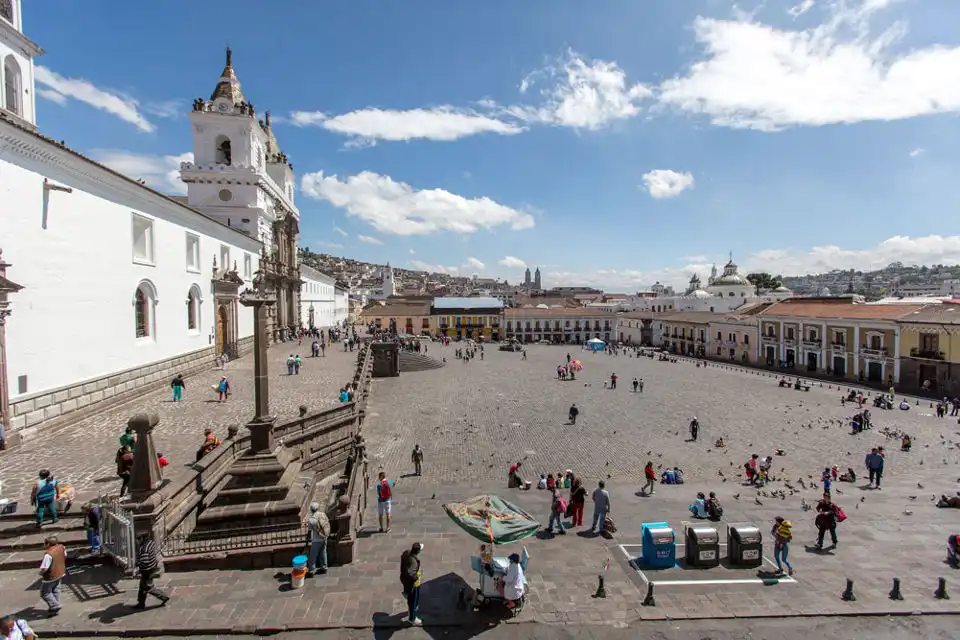
For this reason, exclusive experiences are available to guests of Casa Gangotena, including climbing to the rooftop of the church at sunset, which offers unparalleled views of the plaza (and an opportunity to peep into Casa Gangotena).
What can you do in San Francisco Plaza?
San Francisco Plaza stands as a vibrant hub of culture and history in the heart of Quito, surrounded by the landmarks of Quito that tell the story of the city’s rich heritage. Among these, Casa Gangotena on Simon Bolivar street shares its space with ARIU Studio, a jewelry shop that has been a fixture of the square for over a decade. This shop specializes in exquisite gold and silver pieces designed by Byron Ushiña, a descendant of the ancient Imbaya people, offering a connection to the ancestral accessories and ornaments of the region. Each piece, whether a pendant, bangle, or earring, is displayed over Pre-Columbian figurines, adding a touch of historical reverence to the shopping experience.
Another of Casa Gangotena’s neighbors is Nua Ami Ethno Shop, a beautifully curated collection of artisanal wares and souvenirs from 60 craftsmen and women from across the country. The most eye-catching item of its window displays is the Aruchico, a hat worn in the indigenous San Juan and San Pedro fiestas. Made of cloth, it is decorated with small mirrors and multi-colored ribbons cascading from the sides, like a rainbow-hued jellyfish.
Explore Quito from the heart of the city
Crossing the square to its southwestern flank is Homero Ortega Panama Hats, a small selection of the wonderful headwear that is crafted in the highland city of Cuenca with demonstrations of how these iconic hats are made.
Better still is the hat shop across the square directly opposite Casa Gangotena, Casa Montecristi. This is one of the Historic Quarter’s finest hat shops that sells special headwear made in the coastal province of Manabí – where the palm that supplies the fibres grow. Recognized by UNESCO as part of the world’s cultural heritage, these elegant hats (with their trademark black bands) fetch between US$30 and US$8,000 – the most expensive ones are distinguished by their “thread count” of more than 40 stitches per inch, measured with a special magnifying glass and ruler.
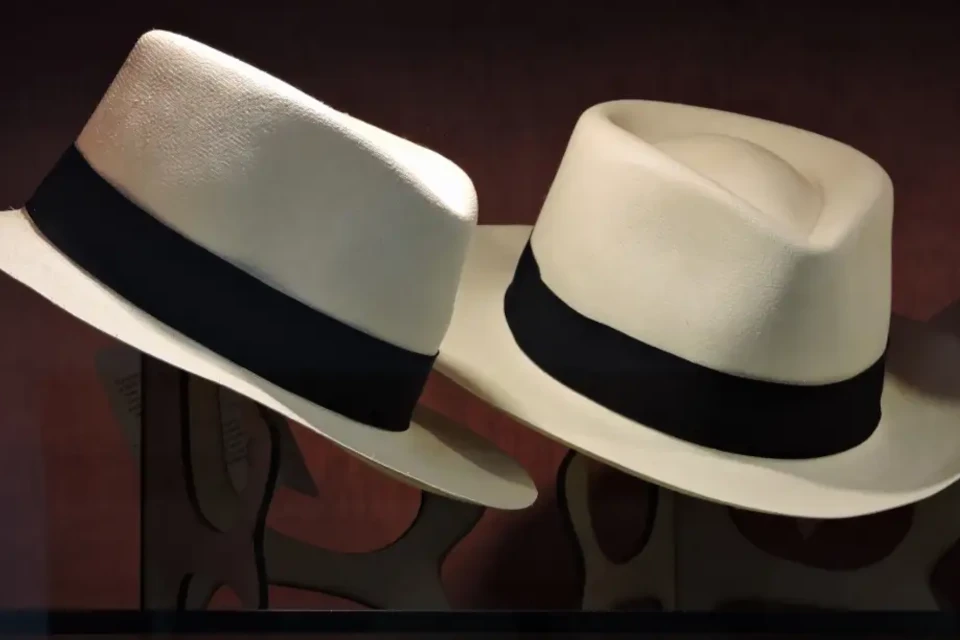
Steps away, occupying the arches underneath the San Francisco religious complex’s atrium lies Tianguez, a multipurpose cultural hotspot. One of its uses is as a café/restaurant, with the option to sit outside, al fresco style, right by the square itself, looking up at Casa Gangotena and watching San Francisco life go by. It is also a brilliant artisan shop, showcasing local crafts from all around the country and selling them at fair-trade prices. But so comprehensive is Tianguez (which means marketplace in ancient Quito dialects) that it’s more like a museum of Ecuadorian artefacts rather than just a store and cafe. The space unfolds like a rabbit warren, tunneling deeper and deeper underneath the complex. Its narrow passageways display technicolored animal masks, engraved ceramics, and, right at the end, the showstopper: erotic art from the Jama-Coaque culture that once thrived on the Pacific Coast.
What’s the Famous Legend Surrounding San Francisco Plaza?
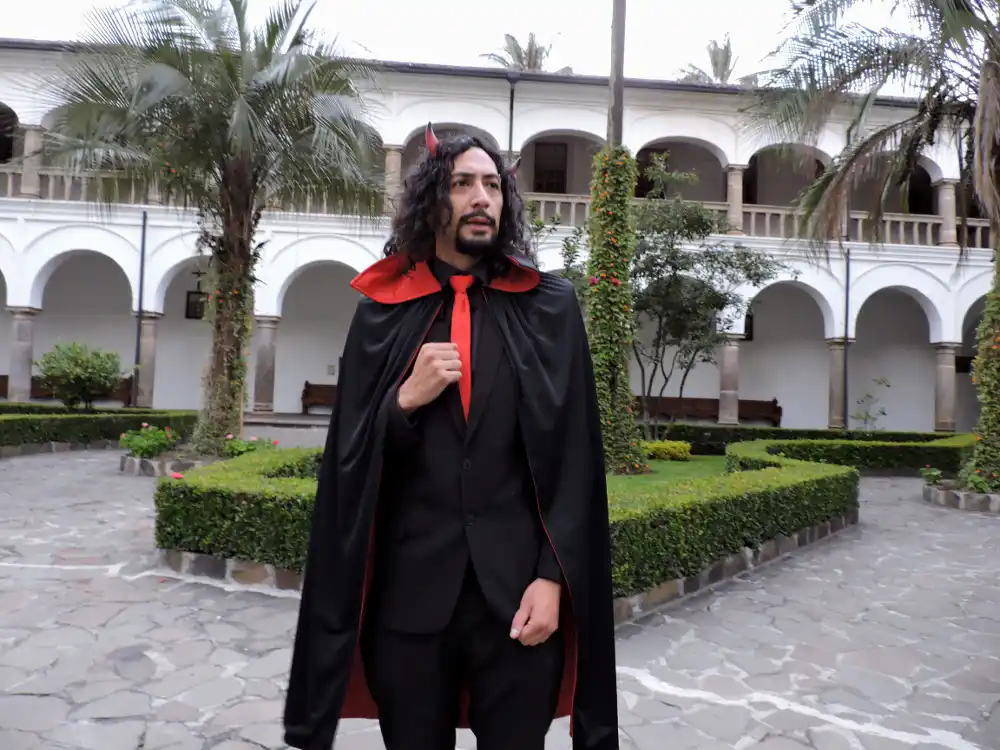
If there is one San Francisco Plaza folktale that every Quiteño knows by heart, it is that of Cantuña and the Devil. Francisco de Cantuña was a humble stonemason assigned with paving the church’s atrium, in the upper part of the Plaza. But Cantuña was idle and realized with a shock that he had just one day left to finish his task, or risk a fine or worse punishment. So, cunning Cantuña, when his prayers to God were left unanswered, called upon Satan, and the two made a deal that if the Angel of Darkness finished laying every single stone by sunrise, the stonemason’s soul would be consigned to the depths of hell. Lucifer diligently fulfilled his part of the bargain, putting every stone in its place. All but one, that is, as crafty Cantuña had hidden it, therefore invalidating the accord and saving himself from his diabolic fate. It is said that the flock of restless pigeons that roost and fly perpetually around Plaza San Francisco Plaza, whose wings can be heard from the terrace of Casa Gangotena, are the souls of lost devils searching for Cantuña.
Cantuña’s story doesn’t end here: the craftsman would have an entire chapel dedicated to him, one that was reserved only for slaves, indigenous people and tradesmen and women.
But, all legends aside, the atrium of San Francisco is an inspiring and fascinating place to stand, its double half-moon circular staircase a spectacular vantage point over the Plaza, a spot for contemplation and watching all of Quito Old Town’s worlds converge.
What is there around the San Francisco Plaza?
If Plaza San Francisco is the beating heart of Quito Old Town (and Casa Gangotena one of its powerful muscles) then the streets leading off it are the veins and arteries carrying life-giving oxygen to the rest of the city. Full of vitality, tradition and history themselves, these are the first streets you will come to when setting out from our Quito hotel. There is Benalcázar, the long street that leads steeply up towards the Basílica del Voto Nacional.
The right-hand side is known as the Jesuit block, an entire block which was bought little by little by this late-coming (and later, unpopular) religious order. On the other side of the block is the entrance to some of its most famous and illustrious constructions: the Metropolitan Cultural Center and the La Compañía church. But back to Benalcázar, the street is home to Café Aguila del Oro, one of the most traditional coffee shops in the city, which has occupied the same spot since 1948 – the old school contraptions and rich café from the southern province of Loja are testament to its antiquated origins.
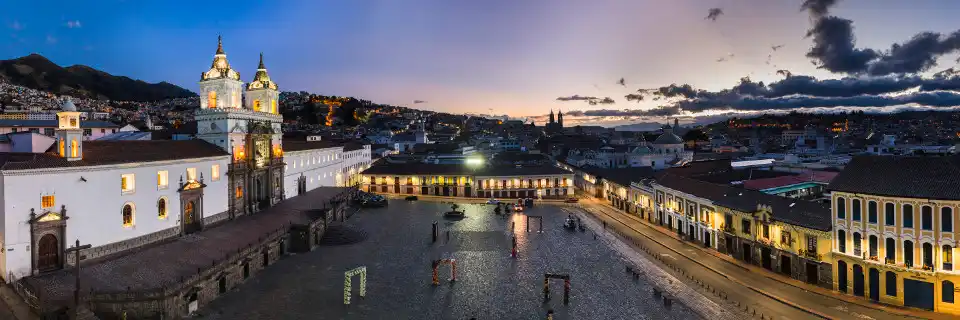
The People’s Plaza
To watch Plaza San Francisco, either from your hotel room, the third-floor terrace, from the rafters of the church or from the center of the square itself, is to observe Quito Old Town life in all its many forms. The children stomping among and scattering the pigeons, the vendors hoarse with their calls, the monks hurrying, worshippers on their way to mass, even the drunk lying in the sunshine on the half-moon staircase: these are the people of Quito’s Old Town who make your experience here richer and more colorful. So if you’re wondering: “where can I stay Quito”, only from Casa Gangotena you too can become part of Plaza Francisco and its never-ending story.
